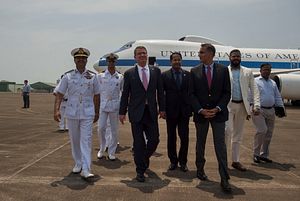India and the United States may sign an agreement for the coproduction of Lockheed Martin F-16V and Boeing F/A-18 fighter aircraft, according to Indian and U.S. defense officials. The deal is likely to involve technological transfers and the local production of U.S. fighter jets in India to meet Indian Prime Minister’s Narendra Modi’s so-called Make in India Initiative.
“Members of my team, and industry, are right now, as we are here in New York, in India looking at the potential coproduction of fighter aircraft,” U.S. Defense Secretary Ash Carter said during a speech at the New York-based Council on Foreign Relations prior to departing on a three-day visit to India. “I have no doubt that in the coming years, the United States and India will embark on a landmark co-production agreement that will bring our two countries closer together and make our militaries stronger, “Carter added.
Senior Indian defense officials have confirmed that the Indian government could approve the establishment of joint-production facilities during Carter’s visit to the country this week:
Defense Minister Manohar Parrikar will once again strike a tough bargain for India (…) a bargain that will see the country benefiting on both the economic and strategic front besides gaining immensely on the technical front…. setting up of a manufacturing line in India for either F-16 aircrafts or F/A18 super hornet jet fighters may be announced.
Defense News reports that both Boeing and Lockheed Martin have confirmed the ongoing negotiations. “Lockheed Martin is in discussions with the U.S. Government, the Government of India, and our Indian industry partners about potential new production F-16 aircraft to address India’s fighter recapitalization requirements,” revealed a Lockheed Martin spokesperson.
As my colleague Ankit Panda reported previously, talks between Boeing and the Indian government over the procurement of F-18s have been going on at least since the beginning of the year. One of the major stumbling blocks ahead in the negotiations will be what technological know-how the U.S. government will permit to be transferred to India—indeed the entire deal may hinge on the precise details of that part of the agreement.
“We are not discussing buying the fighter (aircraft). We want to make it in India through transfer of technology for our requirement,” said Indian Defense Minister Parrikar, according to an April 9 Indian media report. “[U]nless the American government gives permission to transfer a particular technology, the American companies, even if they want to do it, cannot.”
U.S. defense contractors Boeing and Lockheed Martin, along with their F-16 and F-18 aircraft, were outbid in 2011 under the now-scrapped $20 billion MMRCA (medium multi-role combat aircraft) project by French aircraft maker Dassault Aviation, with India opting for Dassault Aviation’s Rafale fighter instead in January 2012. However, the MMRCA project was cancelled after years of difficult negotiations in July 2015.
In its place, New Delhi decided that it will only purchase 36 off-the-shelf Rafale aircraft in a government-to-government deal. Yet, to this date no final contract between India and France for the procurement of the fighter jets has been signed and a deadlock persists. (One major obstacle remains the offset clause which stipulates that France will have to invest 50 percent of the contract value as offsets in India.)
Should the Rafale deal be signed, it is unlikely that India will acquire F-16 or F-18 fighter jets given, among other things, the extra cost that setting up a separate logistical base for the U.S. aircraft would entail. Maintaining a fleet of French, Russian, and U.S. fourth-generation aircraft would be both impractical and wasteful for the Indian Air Force.
And while the Rafale deal is currently deadlocked, it still has a higher chance of being concluded than a possible U.S.-Indian fighter aircraft deal, given the months of detailed negotiations that have already taken place between India and France that have addressed the majority of outstanding issues.
When it comes to Indian defense deals (or any defense deals for that matter), it is the details that have often proved to be the undoing of foreign defense contractors, including offset clauses, Indian demands for technical modifications and reconfigurations, as well as the signing of detailed cost-sharing agreements. Historically, it is during this detailed negotiation phase that talks have the biggest chance of breaking down.
As a consequence, even if a preliminary agreement between Carter and Parrikar will be concluded this week, it is unlikely that a final contract will be signed in the immediate aftermath (or at all). India’s interest in U.S. aircraft may indeed just be just a move to strengthen New Delhi’s negotiating position vis-a-vis Paris and to obtain additional concessions before finally signing the inter-governmental agreement for the Rafale fighter jets.
































